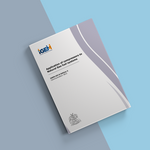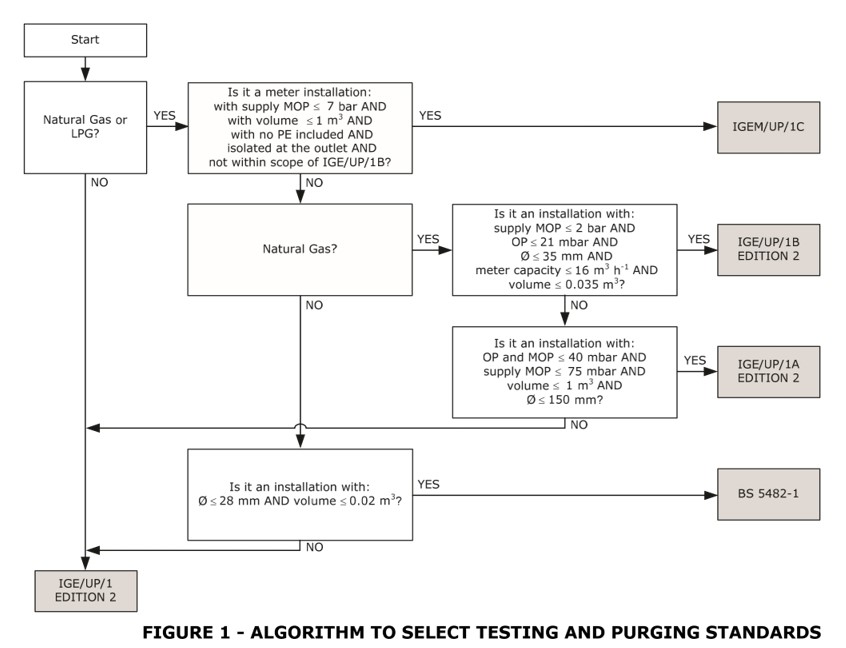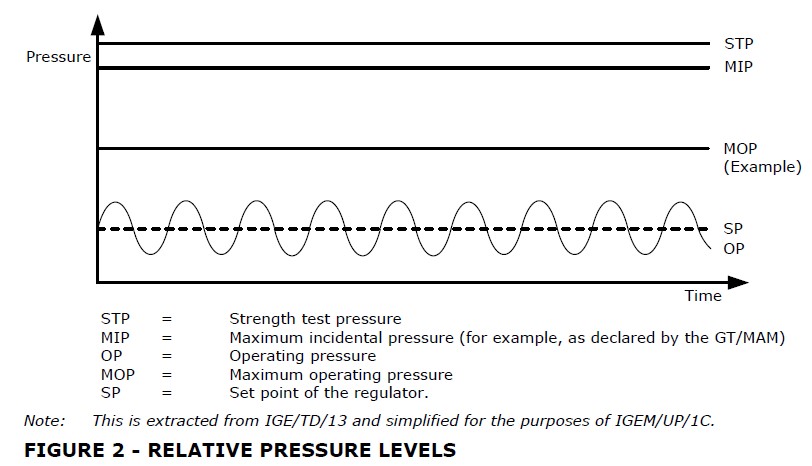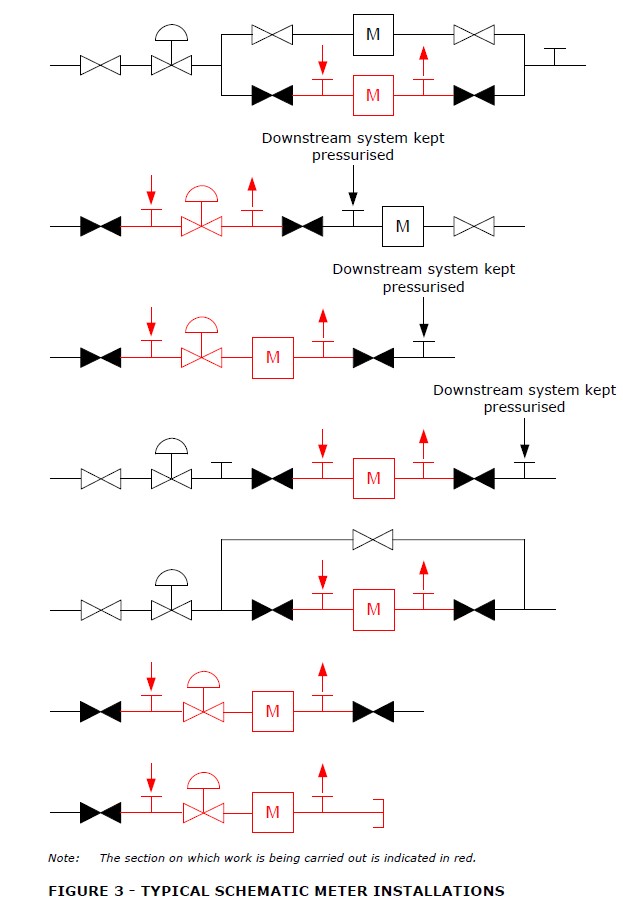IGEM/UP/1C - Strength testing, tightness testing and direct purging of Natural Gas and LPG meter installations

This standard applies for any meter installations:
- Supplying natural gas or liquefied petroleum gas (LPG)
- MOP ≤ 7 bar
- With a volume not exceeding 1 m3
- Having a method of temporarily sealing the outlet of the installation/section
- Not including polyethylene pipe or fitting
- Which is not within the scope of IGEM/UP/1B.
It covers pneumatic strength and tightness testing, along with direct purging. It covers testing in the following circumstances:
- Prior to a new installation being commissioned with gas
- Where a leak is suspected to exist on an existing installation
- Where a new section has been added into an existing installation
- Where there has been a complete loss of pressure, for any reason.
It covers direct purging in the following situations:
- New installation
- Alteration to, replacement of, or reuse of, an existing installation
- Where there has been a complete loss of pressure for any reason
- Where there is the possibility of air being present in an installation
- Where an installation is to be taken temporarily or permanently out of service.
Having a method of temporarily sealing the outlet of the installation/section, for example a valve, blanking device, etc.
IGEM/UP/1C recommends that if an installation is within scope of IGE/UP/1B then IGE/UP/1B should be used. This applies whether or not there is a means of isolation on the outlet.
IGEM/UP/1C is most useful for those meter installations that have a means of isolation on the outlet, are out of scope of IGE/UP/1B and where there is no desire to test the installation pipework downstream of the meter installation.
In the main IGEM/UP/1C is aimed at those who undertake meter installation/replacement work e.g Meter Asset Manage.
Introduction
1.1 This Standard has been drafted by an Institution of Gas Engineers and Managers (IGEM) Panel, appointed by IGEM’s Gas Utilization Committee, and has been approved by IGEM’s Technical Co-Ordinating Committee on behalf of the Council of IGEM.
1.2 It is necessary to check the scope of referenced standards given below. Figure 1 shows the most suitable Standard for a particular situation.
IGEM/UP/1C deals with strength testing, tightness testing and direct purging of meter installations (as defined in IGEM/G/1), containing either Natural Gas (NG) or liquefied petroleum gas (LPG), of volume not exceeding 1 m3 and MOP not exceeding 7 bar.
IGE/UP/1 Edition 2 deals with all aspects of strength testing, tightness testing and direct purging of selected 1st, 2nd and 3rd family gases. For example, for NG, it covers pipework downstream of the emergency control valve (ECV) of maximum operating pressure (MOP) not exceeding 16 bar.
IGE/UP/1A Edition 2 deals with strength testing, tightness testing and direct purging of NG installations of volume not exceeding 1 m3 and diameter not exceeding 150 mm, of MOP (and operating pressure (OP)) not exceeding 40 mbar and supply MOP not exceeding 75 mbar.
IGE/UP/1B Edition 2 deals with tightness testing and purging of NG installations of volume not exceeding 0.035 m3, capacity not exceeding 16 m3 h-1, diameter not exceeding 35 mm, OP not exceeding 21 mbar and supply MOP not exceeding 2 bar.
Note: At the time of publication, it is anticipated that IGEM/UP/1B Edition 3 will cover LPG.
BS 5482-1 deals with tightness testing of domestic-sized LPG pipework (volume not exceeding 0.02 m3). For greater volume, IGE/UP/1 Edition 2 applies.
Note: See above regarding LPG in IGEM/UP/1B Edition 3.
If it is preferred (it is not recommended, as it is more complex to follow) IGE/UP/1 Edition 2 can be used rather than IGE/UP/1A Edition 2, IGE/UP/1B, IGEM/UP/1C or BS 5482-1.
If IGE/UP/1A Edition 2 or IGE/UP/1B Edition 2 or IGEM/UP/1C or BS 5482-1 are not indicated, then it is essential that IGE/UP/1 Edition 2 is used. At the time of publication, neither IGE/UP/1B Edition 2 nor BS 5482-1 require strength testing.

1.3 “MOP” and other new terms such as “maximum incidental pressure” (MIP) and OP have been introduced to reflect gas pressure terminology used in European standards. IGEM/G/4 defines these terms and IGE/GM/8 Part 1 explains them in greater detail.
Referring to Figure 2, note how OP is shown to oscillate about the set point (SP). Note also that MOP can be declared at any value from OP upwards to a limit below MIP. The strength test pressure (STP) has to be at least 110% MIP and in many cases (see Table 4) will be greater.

FIGURE 2 - RELATIVE PRESSURE LEVELS
1.4 This Standard makes use of the terms “must”, “shall” and “should” when prescribing particular requirement. Notwithstanding Sub-Section 1.7:
- the term “must” identifies a requirement by law in Great Britain (GB) at the time of publication
- the term “shall” prescribes a requirement which, it is intended, will be complied with in full and without deviation
- the term “should” prescribes a requirement which, it is intended, will be complied with unless, after prior consideration, deviation is considered to be acceptable.
Such terms may have different meanings when used in legislation, or Health and Safety and Executive (HSE) Approved Code of Practice (ACoPs) or guidance, and reference needs to be made to such statutory legislation or official guidance for information on legal obligations.
1.5 The primary responsibility for compliance with legal duties rests with the employer. The fact that certain employees, for example “responsible engineers”, are allowed to exercise their professional judgement does not allow employers to abrogate their primary responsibilities. Employers must:
- have done everything to ensure, so far as it is reasonably practicable, that “responsible engineers” have the skills, training, experience and personal qualities necessary for the proper exercise of professional judgement • have systems and procedures in place to ensure that the exercise of professional judgement by “responsible engineers” is subject to appropriate monitoring and review
- not require “responsible engineers” to undertake tasks which would necessitate the exercise of professional judgement that is not within their competence. There should be written procedures defining the extent to which “responsible engineers” can exercise their professional judgement. When “responsible engineers” are asked to undertake tasks which deviate from this they should refer the matter for higher review.
1.6 It is now widely accepted that the majority of accidents in industry generally are in some measure attributable to human as well as technical factors in the sense that actions by people initiated or contributed to the accidents, or people might have acted in a more appropriate manner to avert them.
It is therefore necessary to give proper consideration to the management of these human factors and the control of risk. To assist in this, it is recommended that due regard be paid to HSG48.
1.7 Notwithstanding Sub-Section 1.4, this Standard does not attempt to make the use of any method or specification obligatory against the judgement of the responsible engineer. Where new and better techniques are developed and proved, they should be adopted without waiting for modification to this Standard. Amendments to this Standard will be issued when necessary, and their publication will be announced in the Journal of the Institution and other publications as appropriate.
1.8 Requests for interpretation of this Standard in relation to matters within its scope, but not precisely covered by the current text, should be addressed in writing to Technical Services, IGEM, IGEM House, High Street, Kegworth Derbyshire, DE74 2DA and will be submitted to the relevant Committee for consideration and advice, but in the context that the final responsibility is that of the engineer concerned. If any advice is given by or on behalf of IGEM, this does not relieve the responsible engineer of any of his or her obligations.
1.9 This Standard was published in March 2011.
Scope
2.1 This Standard applies for any meter installation (or part thereof):
Note: Meter installation is defined in IGEM/G/1 and IGEM/G/4.
- supplying Natural Gas or LPG
- MOP < 7 bar
- with a volume not exceeding 1 m3
- having a method of temporarily sealing the outlet of the installation/section, for example a valve, blanking device, etc.
- not including polyethylene (PE) pipe or fittings
- which is not within scope of IGE/UP/1B (see Figure 1).
Note 1: The diversity of meter installations is such that it is inappropriate to provide detailed guidelines for all types of meter installation covered by the scope of this Standard. It is recognised that special circumstances may occur, on a meter installation, for which some of the requirements in this Standard cannot be applied. In such a case, IGE/UP/1 applies and the procedure needs to be developed by personnel with the relevant competency and experience.
Certain “legacy” meter installations do not comply with the Standard arrangements given in IGEM/G/1. The principles of this Standard may be applied to the majority of such legacy installations.
Note 2: “Meter installation (or part thereof)” is hereafter referred to as “meter installation”.
Note 3: Typical schematic meter installations are shown in Figure 3.
2.2 This Standard covers pneumatic strength testing and tightness testing, and direct purging. It does not address hydrostatic testing.
2.3 This Standard covers strength testing and/or tightness testing in the following circumstances:
- prior to a new installation being commissioned with gas
- where a leak is suspected to exist on an existing installation
- where a new section has been added into an existing installation
- where there has been a complete loss of pressure, for any reason, for example component replacement, section replacement, etc.
Typical schematic installations are shown in Figure 3.
2.4 This Standard covers direct purging in the following circumstances:
- new installation
- alteration to, replacement of, or re-use of, an existing installation • where there has been a complete loss of pressure for any reason
Note: The closure of a valve, for example the ECV, can result in a complete loss of pressure which necessitates tightness testing and purging before resumption of supply. - where there is the possibility of air being present in an installation
- where an installation is to be taken temporarily or permanently out of service.
2.6 Italicised text is informative and does not represent formal requirements.
2.7 Appendices are informative and do not represent formal requirements unless specifically referenced in the main sections via the prescriptive terms “must”, “shall” or “should”.
2.8 IGEM/UP/1C adopts the concept of “Gauge readable movement” (GRM). When using a water gauge, it may be possible to reduce the duration of tests by adopting the concept of “no perceptible movement”.

